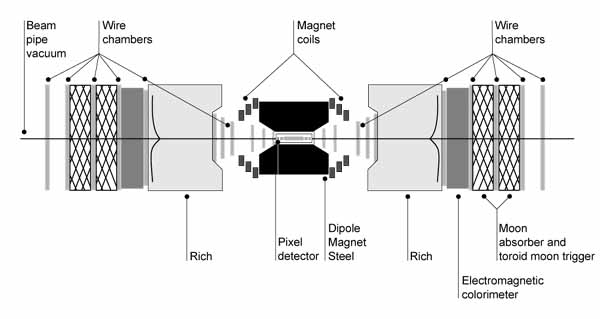 |
|
BTeV by Mike Perricone
Now BTeVóthe newly approved experiment in B physics at the Tevatronóhopes to reach toward major discoveries in the next decade, moving beyond experiments that have already begun operation. The experiment received the go-ahead from Fermilab's Physics Advisory Committee during its June 17-24 meeting in Aspen, Colorado. The PAC report said BTeV, an "ambitious" experiment with "an elegant and challenging detector...could be the definitive experiment that ultimately clarifies the picture of CP violation," the difference in behavior between matter and antimatter holding the key to the composition of the universe. Accepting the PAC recommendation, director Michael Witherell said: "Building on the contributions of the other B-factories, BTeV represents the most important experimental program that can be done in the U.S. program at the end of this decade before the completion of a new facility." BTeV, with an estimated cost of about $150 million and a possible roll-in date of 2006, is aiming high. "The dream, of course, is to defeat the Standard Model in some important way," said experiment co-spokesperson Joel Butler. The Standard Model has structured scientists' view of particle physics since the 1970s. CP violation has been a fact of life for particle physicists since James Cronin's and Val Fitch's Nobel Prize-winning discovery in 1964 involving kaons, particles containing a strange quark. Experiments at Fermilab (KTeV) and CERN (NA48) have added significant advances in kaon CP violation, and Fermilab's CDF collaboration added a recent observation in B physicsósignificant as a sign of possible CP violation outside the kaon system. The bottom quark was discovered at Fermilab in 1977. Mesons (quark-antiquark pairs) containing the bottom quark offer two great advantages in studying CP violation: first, they produce many possible decay modes to study; second, some of these decays show large and (potentially) easily measurable differences in behavior between the resultant particles and antiparticles.
The new experiments are called "B factories." Billions of paired B mesons and anti-B mesons will emanate from high-energy accelerators like brand-name tools coming off assembly lines. In a sense, though, the Tevatron has always been a B-factory: its proton-antiproton collisions are a prolific source of B mesons. The CDF and DZero collider experiments are now learning how to use B's effectively, but BTeV is specifically designed to use B's to study CP violation. "We can make the most comprehensive measurements, while examining the whole pattern of CP violation," Butler said. "Are they all related, reinforcing the Standard Model? Or are they not relatedómeaning we're seeing new physics." Several B factories are already operating: BaBar (using electron-positron collisions) at Stanford Linear Accelerator Center in California; BELLE (electron-positron) at KEK, the High Energy Accelerator Research Organization in Tsukuba, Japan; and Hera-B (electron-proton) at Deutsches Elektronen-Synchrotron in Hamburg, Germany. BaBar and BELLE will soon present their first results, and go on to precision measurements. Another B-factory is planned: LHC-B (proton-proton), for the Large Hadron Collider being built at CERN in Geneva, Switzerland. This experiment would operate contemporaneously with BTeV. So the BTeV collaborators had to make a strong case to the PAC. They did it by demonstrating their ability to measure some of the most difficult parameters of CP violation in the decays of Bd (containing a bottom quark and a down antiquark) and Bs (a bottom quark and a strange antiquark) mesons. These parameters will still be in question even after years of study by current experiments. "What we tried to do in the PAC was to look ahead almost 10 years to the later stages of this program, and to ask what results would be needed to complete it," said PAC member and eminent theorist Michael Peskin of SLAC. "I am sure that BTeV will have an important role to play." The BTeV detector, which will be located at the new CZero collision hall, has characteristics which experimenters believe can compensate for LHC-B's energy advantage. BTeV uses a high-quality photon detector based on research and develop-ment at Fermilab for LHC's Compact Muon Solenoid Detector-technology, which did not exist when LHC-B was designed and approved. BTeV also uses a pixel detector just six millimeters from the beam, with unprecedented computing power in its triggering. The decay vertices seen with this pixel detector will be applied to the first-level triggerósomething no other experiment has accomplished. Fermilab theorist and PAC member Andreas Kronfeld said BTeV would break new ground in the design of its trigger. He also noted the impressive BTeV presentation. "We grappled with BTeV for most of my term on the PAC," said Kronfeld, whose term ended after four years. "We held the bar very high. They just kept jumping over it, even if we moved the bar while they were still in the air." The PAC and Witherell both emphasized that the Tevatron's first Run II priority is the search for the Higgs boson and other new physics at the highest energies. LHC will succeed the Tevatron at the energy frontier later in this decade, but BTeV can establish the Tevatron as a premier B factory. "The collaboration is pretty pumped up," Butler said. "BTeV has what it takes to do this kind of physics." |
| last modified 7/21/2000 email Fermilab |
FRLsDFx9eyfrPXgV
 In less than a quarter-century, the field of B physics has moved from solitary exploration to mass exploitation of the family of ephemeral particles containing the bottom quark.
In less than a quarter-century, the field of B physics has moved from solitary exploration to mass exploitation of the family of ephemeral particles containing the bottom quark.
